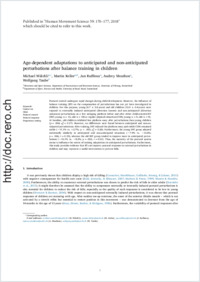Age-dependent adaptations to anticipated and non-anticipated perturbations after balance training in children
- Wälchli, Michael Movement and Sport Sciences, Department of Neurosciences and Movement Sciences, University of Fribourg, Switzerland
- Keller, Martin Movement and Sport Sciences, Department of Neurosciences and Movement Sciences, University of Fribourg, Switzerland - Department of Sport, Exercise and Health, University of Basel, Basel, Switzerland
- Ruffieux, Jan Movement and Sport Sciences, Department of Neurosciences and Movement Sciences, University of Fribourg, Switzerland
- Mouthon, Audrey Movement and Sport Sciences, Department of Neurosciences and Movement Sciences, University of Fribourg, Switzerland
- Taube, Wolfgang Movement and Sport Sciences, Department of Neurosciences and Movement Sciences, University of Fribourg, Switzerland
-
01.06.2018
Published in:
- Human Movement Science. - 2018, vol. 59, p. 170–177
English
Postural control undergoes rapid changes during child development. However, the influence of balance training (BT) on the compensation of perturbations has not yet been investigated in children. For this purpose, young (6.7 ± 0.6 years) and old children (12.0 ± 0.4 years) were exposed to externally induced anticipated (direction known) and non-anticipated (direction unknown) perturbations on a free swinging platform before and after either child-oriented BT (INT; young: n = 12, old: n = 18) or regular physical education (CON; young: n = 9, old: n = 9). At baseline, old children exhibited less platform sway after perturbations than young children (p = .004; η2p = 0.17). However, no differences were found between anticipated and non- anticipated perturbations. After training, INT reduced the platform sway path while CON remained stable (−11.1% vs. +2.7%; p < .001; η2p = 0.26). Furthermore, the young INT group adapted statistically similarly in anticipated and non-anticipated situations (−7.9% vs. −12.6%; p = .556; r = 0.33), whereas the old INT group tended to improve more in anticipated perturbations (−15.1% vs. −8.2%; p = .052; r = 0.51). Thus, the maturity of the postural system seems to influence the extent of training adaptations in anticipated perturbations. Furthermore, this study provides evidence that BT can improve postural responses to external perturbations in children and may represent a useful intervention to prevent falls.
- Faculty
- Faculté des sciences et de médecine
- Department
- Département de Médecine
- Language
-
- English
- Classification
- Biological sciences
- License
-
License undefined
- Identifiers
-
- RERO DOC 322928
- DOI 10.1016/j.humov.2018.04.006
- Persistent URL
- https://folia.unifr.ch/unifr/documents/307159
Statistics
Document views: 131
File downloads:
- pdf: 180
